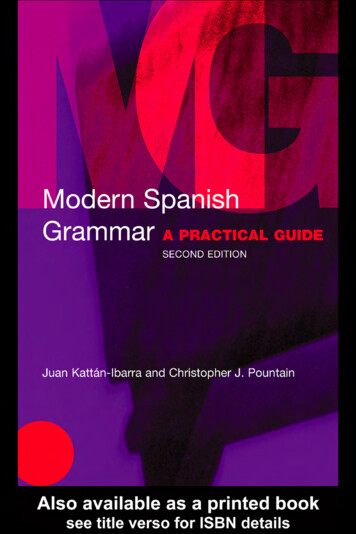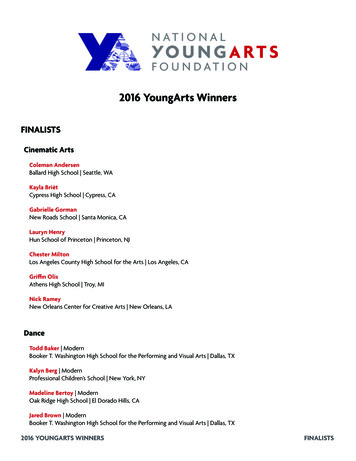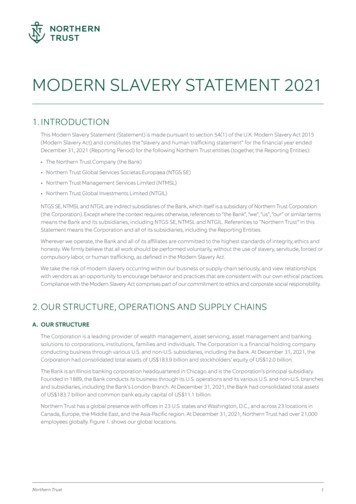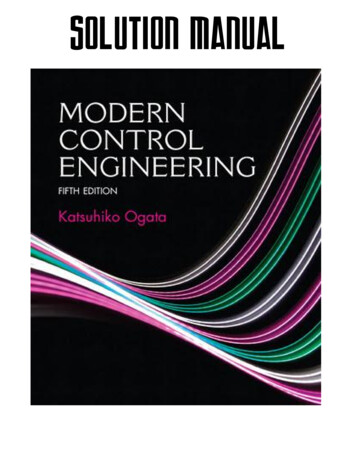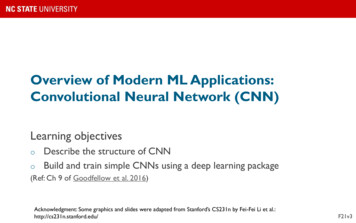
Transcription
Overview of Modern ML Applications:Convolutional Neural Network (CNN)Learning objectivesooDescribe the structure of CNNBuild and train simple CNNs using a deep learning package(Ref: Ch 9 of Goodfellow et al. 2016)Acknowledgment: Some graphics and slides were adapted from Stanford’s CS231n by Fei-Fei Li et al.:http://cs231n.stanford.edu/F21v3
Convolutional Neural Network (CNN)The single most important technology that fueled the rapiddevelopment of deep learning and big data in the past decade.& nonlinearactivationor pooling& nonlinearactivationor poolingLeCun, Bottou, Bengio, Haffner, “Gradient-Based Learning Applied to Document Recognition,” Proc. IEEE, 1998.2
Why is Deep Learning so Successful?1. Improved model: convolutional layer, more layers (“deep”), simpleractivation (i.e., ReLU), skip/residual connection (i.e., ResNet), attention(i.e., Transformer)2. Big data: huge dataset, transfer learning3. Powerful computation: graphical processing units (GPUs) Example of big data: ImageNet (22K categories, 15M images)Deng, Dong, Socher, Li, Li & Fei-Fei, “ImageNet: A Large-Scale Hierarchical Image Database,” IEEE CVPR, 2009.3
(Fei-Fei Li et al., CS231n)4
Linear Model to Neural Network5
Fully-Connected Layer for 1D Signal6
Fully-Connected Layer for RGB Image(Fei-Fei Li et al., CS231n)7
Convolutional Layer for 1D Signal8
Convolutional Layer for 2D Matrix/Image2D ConvolutionMultiple colorchannels needmultiple filter masks9
Convolutional Layer for RGB Image(Fei-Fei Li et al., CS231n)10
(Fei-Fei Li et al., CS231n)11
(Fei-Fei Li et al., CS231n)12
Six 5x5x3 filters(Fei-Fei Li et al., CS231n)13
Building Block for Modern CNN(Rectified Linear Unit)14
CNN is composed of a sequence of convolutional layers,interspersed with activation functions (ReLU, in most cases).Source of nonlinearity, ReLU:(Fei-Fei Li et al., CS231n)15
(Fei-Fei Li et al., CS231n)16
AlexNetResNet(Fei-Fei Li et al., CS231n)17
Residual Neural Network (ResNet) [Kaiming He et al., 2015] Skip connections or shortcuts are added. They canLayer 1 avoid “vanishing gradients”, and make optimization landscape flatter. From Taylor expansion perspective, the neuralnetwork only learns the higher-order errorterms beyond the linear term x. Has interpretations in PDE. Preferred modern NN structure.Layer 2Layer 318
When Output is Categorical / Qualitative A softmax layer is needed: Softmax function: Ex:Winner takes all!19
Other Essential Aspects of CNN Due to time constraints, this overview lecture covered only thestructural elements of CNNs. Other essential aspects are: Cost function, e.g., MSE, cross entropy. (will cover if time permits.) How to train CNNs (estimate the weights), i.e., backpropagation. (willcover if time permits.) Practical training considerations including How to determine number of hidden units/channels to be used, How to tune learning rate and batch size, and When to stop training (number of epochs). For a more complete treatment on CNN, refer to the dedicatecourses such as CS231n CNNs for Visual Recognition.20
Machine Learning (ML) and Data Science (DS) Follow-up machine learning / data science courses: ECE 542 Neural Nets and Intro to Deep Learning ECE 592-61 Data Science ECE 759 Pattern Recognition and Machine Learning ECE 763 Computer Vision ECE 792-41 Statistical Foundations for Signal Processing & Machine Learning Any courses/videos on YouTube, Coursera, etc. State-of-the-art theory & applications: ICML, NeurIPS, ICLR, AAAI Data science competitions: kaggle.com Programming languages for ML/DS: Python, R, Matlab21
Overview of Modern ML Applications:Recurrent Neural Network (RNN)and LSTMAcknowledgment: Some graphics and slides were adapted from Stanford’s CS231n by Fei-Fei Li et al.:http://cs231n.stanford.edu/
A Sequence of Identical Neural Network ModulesForce the neural nets (in green) to be the same to lower the complexity!OutputNNmoduleInputImage Captioning Emotionimage - seq ofClassificationwordsseq of words- emotionMachine Translationseq of words - seq ofwordsVideoclassificationat frame level23
Recurrent Neural Network (RNN): Definitionht : state, xt : inputfW : neural network24
Recurrent Neural Network (RNN):ImplementationDiagram for fW.Can you label the details?tanh( )fW is implemented via- linear transforms Whh and Wxh and- elementwise nonlinear function tanh( )25
Recurrent Neural Network (RNN): Unrolled26
Example: Character-Level Language ModelVocabulary:[h, e, l, o]Embedding:Example trainingsequence:“hello”27
Vocabulary:[h, e, l, o]At test time, samplecharacters one at atime, feed back tomodel28
Long Short-Term Memory (LSTM) NetworkRNN has the “vanishing gradient” problem! Resolved by long short-term memory (LSTM) units. RNNLSTM29
An LSTM Unit [Hochreiter et al., 1997]30
Overview of Modern ML Applications:Transformers and BERTAcknowledgment: Some graphics and slides were adapted ttention-video
How to make good sense of language? Reading comprehension: If you were Google, what result(s) shouldyou return for “brazil traveler to usa need a visa”?1.2. A webpage on U.S. citizens traveling to BrazilA webpage of the U.S. embassy/consulate in BrazilContextualization is the key! A nice walk by the river bank. Walk to the bank and get cash.32
Word Embeddings in Natural Language Processing (NLP)Embedding examples: Bag of Words (BoW), Word2Vec, 33
Word Embeddings are Meaningful Under “ ” and “ ”34
Contextualization by “Attention”35
How does “attention” work?SimilaritymeasureExponential saturation& normalizationLinearcombination
Similarity Measure via Inner Product37
Exponential Saturation & Normalization via Softmax38
Contextualization via Linear CombinationWeights for linear combinationContextualized embeddingsRaw embeddings39
Key,Value, and Query “Key”, “value”, and “query” arethree projections of an inputembedding to three vectorsubspaces. Each subspace represents aunique semantic aspect. The projection operators /matrices provide trainableparameters for Transformerneural networks.(e.g., location)(e.g., preposition)40
Multi-Head Attention41
Bidirectional EncoderRepresentations fromTransformers (BERT)42
Neural Network Training:BackpropagationAcknowledgment: Some graphics and slides were adapted from Profs. Jain (MSU), MinWu (UMD), Fei-Fei Li (Stanford)Some figures are from Duda-Hart-Stork textbook, Fei-Fei Li’s slides
3-Layer Neural Network Structure A single “bias unit” is connected to each unit in addition to the input unitsNet activation:ddi 1i 0net j xi w ji w j 0 xi w ji w tj .x ,where the subscript i indexes units in the input layer, j indexes units in thehidden layer;wji denotes the input-to-hidden layer weights at hidden unit j. In neurobiology, such weights or connections arecalled “synapses” Each hidden unit emits an output that isa nonlinear function of its activationyj f (netj)
Training Neural Networks / Estimating Weights Notations: tk the kth target (or desired) output,zk the kth estimated/computed output with k 1, , c.wij weight of the network1 c1 Squared cost func:J ( w ) ( t k z k )2 t z2 k 122 Learning based on gradient descent by iteratively updating the weights:w(m 1) w(m) w(m), J w The weights are initialized with random values, wand updated in a direction to reduce the error. Learning rate, , controls the step size of the update in weights.
Walking man image is CC0 1.0 public domainFigure source: Stanford CS231n by Fei-Fei Li
Gradient DescentFigure source: Stanford CS231n by Fei-Fei Li
Efficient Gradient Calculation: Backpropagation Computes 𝐽/ 𝑤𝑗𝑖 for a single input-output pair. Exploit the chain rule for differentiation, e.g., J J y j net j . w ji y j net j w jiComputed by forward and backward sweeps over the network,keeping track only of quantities local to each unit. Iterate backward one unit at a time from last layer. Backpropagationavoids redundant calculations.
Backpropagation (BP): An ExampleFigure source: Stanford CS231n by Fei-Fei Li
Network Learning by BP (cont’d) Error on hidden-to-output weight: netk J J netk . k wkj netk wkj wkj δk , the sensitivity of unit k :describes how the overall error changes withthe activation of the unit’s net activation k k J netk J J zk . ( t k zk ) f ' ( netk ) netk zk netk Since netk wkt y , we have net k yj w kj Summary 1: weight update (or learning rule) for the hidden-to-outputweight is: wkj (tk – zk) f’(netk) yj k yj
Network Learning by BP (cont’d) Error on input-to-hidden weight: chain rule: J J y j net j . w ji y j net j w jicc J 1 ( t z ) 2 ( t z ) z k k k kk y j y j 2 k 1 y jk 1c z k net k ( t k zk ). ( t k z k ) f ' ( net k )w kj net yk 1k 1kjc Sensitivity of a hidden unit:𝒄 𝑱𝜹𝒋 𝒇′(𝒏𝒆𝒕𝒋 ) 𝒘𝒌𝒋 𝜹𝒌 𝒏𝒆𝒕𝒋(Similarly defined as earlier)𝒌 𝟏 Summary 2: Learning rule for the input-to-hidden weight is:Δ𝑤𝑗𝑖 𝜂 𝑓 ′ 𝑛𝑒𝑡𝑗 𝑤𝑘𝑗 𝛿𝑘 𝑥𝑖 𝜂𝛿𝑗 𝑥𝑖𝛿𝑗
Sensitivity at Hidden Node
BP Algorithm: Training Protocols Training protocols: Batch: Present all patterns before updating weights Stochastic: patterns/input are chosen randomly from training set; network weights areupdated for each pattern Online: present each pattern once & only once (no memory for storing patterns) Stochastic backpropagation algorithm:Begininitialize nH; w, criterion thres, , m 0do m m 1xm randomly chosen patternwji wji jxi; wkj wkj kyjuntil J(w) thresreturn wEndECE 492-45 Introduction to Machine Learning
BP Algorithm: Stopping Criterion Algorithm terminates when the change in criterion functionJ(w) is smaller than some preset thres Also exist other stopping criteria with better performance A weight update may reduce the error on the single patternbeing presented, but can increase the error on the full trainingset In stochastic backpropagation and batch propagation, we should makeseveral passes (epoches) through the training data
Learning Curves Before training starts, the error onthe training set is high; as the learningproceeds, error becomes smaller Error per pattern depends on theamount of training data and expressivepower (e.g. # of weights) in the network Average error on an independent testset is always higher than on the trainingset, and it can decrease or increase A validation set is used in order to decide when to stop training: Avoid overfitting the network and decrease the power of the classifier’sgeneralization“Stop training when the error on the validation set is minimum”
Practical Considerations: Learning Rate Learning Rate Small learning rate: slow convergence Large learning rate: high oscillation and slow convergence
3-Layer Neural Network Structure A single "bias unit"is connected to each unit in addition to the input units Net activation: where the subscript i indexes units in the input layer, j indexes units in the hidden layer; w ji denotes the input-to-hidden layer weights at hidden unit j. In neurobiology, such weights or connections are called "synapses"

